From world-famous Norwegian mountain railways to lesser-known gems in Sweden, here is the very best of rail travel in Scandinavia. All aboard!
Imagine gliding through a landscape where towering mountains plunge into deep blue fjords, where endless forests give way to serene lakes, and where the sky blazes with the everlasting light of the midnight sun.
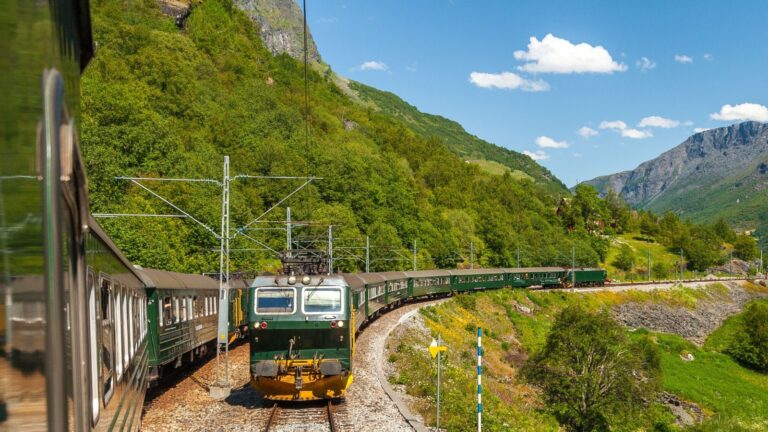
In Scandinavia, train journeys offer not just transportation but an immersive experience through some of the most breathtaking natural scenery in the world.
From Norway's dramatic fjords to Sweden's tranquil lakes and Denmark's rolling coastlines, traveling by train allows you to sit back, relax, and soak in the stunning vistas that define this region.
Train travel is an integral part of life in Scandinavia. The extensive railway networks are known for their comfort, efficiency, and environmental friendliness, making them a popular choice for both locals and tourists.
But beyond the practicalities, it's the scenery that truly captivates. The trains wind their way through landscapes that seem almost untouched by time, offering passengers a front-row seat to nature's grandeur.
Let's take a look at the most scenic train routes in Norway, Sweden, and Denmark, each offering a unique perspective on Scandinavia's natural beauty.
Scenic Railways in Norway
Let's start with rail travel in Norway, home to some of the world's most famous railway routes.
Flåm Railway (Flåmsbana)
The Flåm Railway, or Flåmsbana, is often hailed as one of the most beautiful train journeys in the world.
This 20km route connects the mountain station of Myrdal to the village of Flåm, nestled at the end of Aurlandsfjord, an arm of the famous Sognefjord.
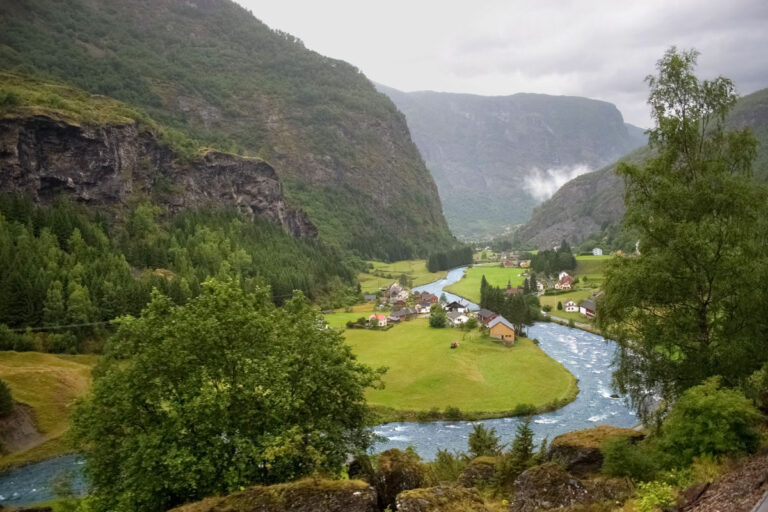
The train descends steeply through a series of tunnels and over bridges, passing by cascading waterfalls, lush valleys, and picturesque villages.
One of the most striking sights along the Flåmsbana is the Kjosfossen waterfall, where the train makes a brief stop, allowing passengers to step out and take in the powerful cascade up close. In the summer, there's often an enjoyable performance included.
The dramatic fjord views, with towering cliffs and deep blue waters, make this journey a photographer's dream. That being said, it can be challenging to snap good photos when the train is full.
While the Flåm Railway is stunning year-round, each season offers a different perspective. In spring and summer, the landscape is lush and green, with waterfalls at their most powerful due to melting snow.
Autumn brings a palette of golden and red hues, while winter transforms the route into a snowy wonderland, offering an almost otherworldly experience. Check out my video about the Flåm Railway in winter here:
Perhaps it's not for everyone, but for me, the winter experience was absolutely magical.
Bergen Line (Bergensbanen)
Connecting Norway's capital, Oslo, to the coastal city of Bergen, the Bergen Line, or Bergensbanen, is a journey through some of Norway's most rugged and remote landscapes.
Spanning over 370km, the railway crosses the Hardangervidda plateau, Europe's largest mountain plateau, reaching altitudes of over 1,200 metres.
As the train climbs higher, the scenery changes from lush forests and tranquil lakes to barren, windswept tundra, often blanketed in snow even in the summer months.
One of the highlights of this journey is passing through Finse, the highest station on the line, where passengers can step off to explore the surrounding area, either by hiking in summer or skiing in winter.
In Finse, you can rent a bike and cycle part of the famous Rallarvegen, a scenic route that follows the old construction road used to build the railway. Alternatively, enjoy a hike and then explore the area’s rich history at the Finse 1222 hotel.
The Rauma Railway (Raumabanen)
The Rauma Railway, or Raumabanen, takes passengers on a dramatic journey through the Romsdal Valley, from Dombås to Åndalsnes.
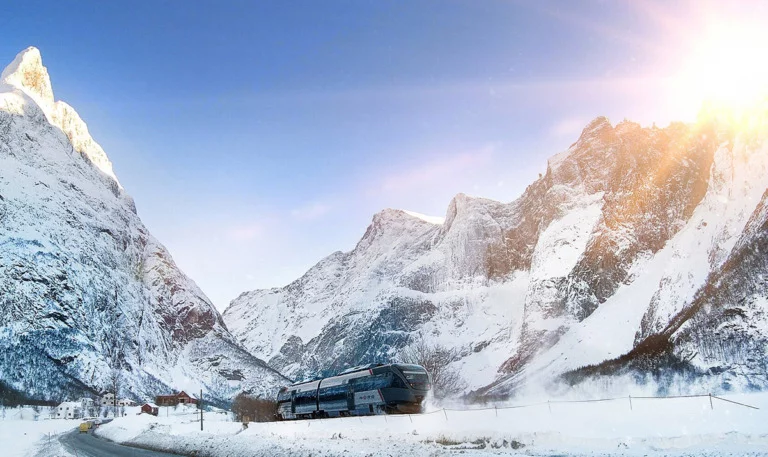
This 114km route follows the Rauma River, winding its way through lush valleys, past towering cliffs, and over stunning bridges.
Highlights of the Rauma Railway include the Trollveggen cliff, Europe’s highest vertical rock face, and the Kylling Bridge, an architectural marvel offering panoramic views of the surrounding landscape.
As the train approaches Åndalsnes, the scenery becomes even more dramatic, with the Romsdal Alps rising steeply on either side of the valley.
The Rauma Railway has long been a source of inspiration for artists and filmmakers. The dramatic landscapes have been featured in several films, including parts of the Harry Potter series.
Scenic Railways in Sweden
Now, let's hop across the border and see what we can find in Sweden.
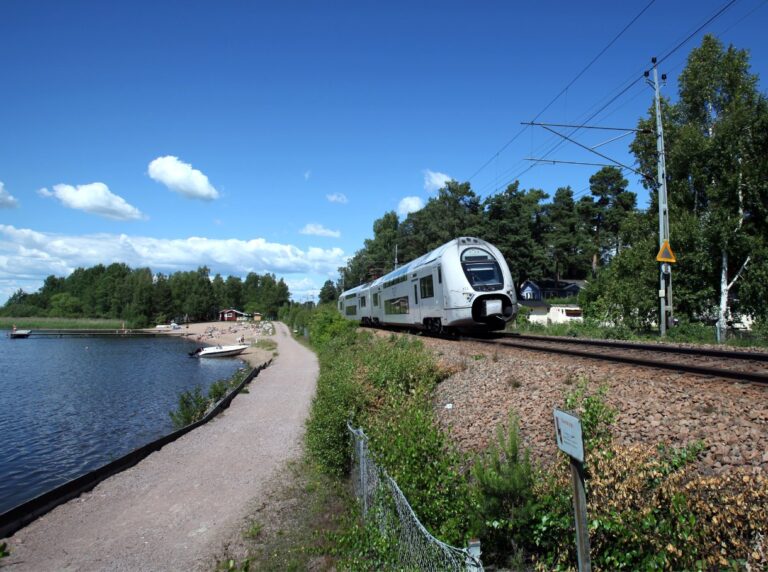
Inland Line (Inlandsbanan)
Primarily a freight line, Sweden's Inlandsbanan becomes a tourist railway in the summer months. It takes travellers on a journey through the heart of Sweden, from Värmland in the south via Dalarna up to the Arctic region.
The journey from Mora (or Kristinehamn via bus) to Gällivare passes through dense forests, across vast plains, and alongside pristine lakes. A highlight is crossing the Arctic Circle, where the landscape becomes more rugged and the sense of remoteness intensifies.
Part of the experience is enjoying delicious foods such as cloudberries, whitefish and reindeer during the scheduled food stops. Snacks and coffee are available on the train itself. All Inlandsbanan trains have knowledgeable train hosts who talk about the scenery you're passing through.
Although Inlandsbanan is a tourist service, Interrail Passes are valid. However, due to the line's popularity, seats must be booked well in advance and there is a small reservation fee.
Arctic Circle Sleeper (Stockholm to Narvik)
The journey from Stockholm to Narvik, often referred to as the Arctic Circle Sleeper Train, is one of the most iconic rail routes in Scandinavia.
This route takes passengers from the bustling Swedish capital, through the vast wilderness of northern Sweden, and into Norway, ending in the coastal town of Narvik.
The scenery along this route is nothing short of spectacular, with endless forests, sparkling lakes, and the occasional glimpse of a traditional red cottage.
As the train crosses into the Arctic Circle, the landscape becomes more rugged, with snow-capped mountains and vast, empty plains. In summer, the midnight sun casts an endless glow over the scenery.
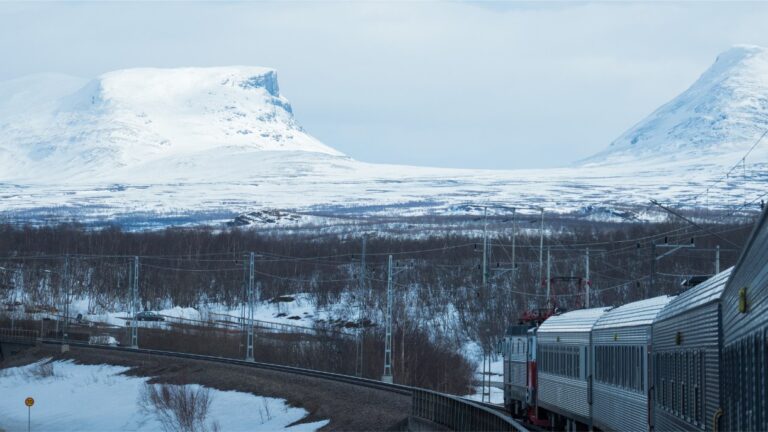
This route is not only known for its scenery but also for its historical importance. The northern part of this rail route was originally built to transport iron ore from the mines in Kiruna to the port of Narvik. During World War II, the route played a crucial role.
In 2020, a summer seasonal passenger service began operations between Narvik and Bjørnfjell (at the Swedish border) and back. Known as The Arctic Train, tickets are sold to cruise ship passengers and the general public.
Rail Travel in Denmark
While Denmark may not have the dramatic mountains of Norway or the vast forests of Sweden, its railway routes offer a convenient mode of transport around this mostly flat country.
Copenhagen-Helsingør Railway
One scenic route in Denmark is the railway from Copenhagen to Helsingør. This short journey takes you along the Øresund coast, offering sea views dotted with sailboats and the occasional glimpse of Sweden across the water.
The route passes through several picturesque towns, including Klampenborg, where you can stop to visit the famous Bakken amusement park, and Humlebæk, home to the Louisiana Museum of Modern Art.
The journey ends in Helsingør, where you can explore the historic Kronborg Castle, famously known as the setting for Shakespeare's Hamlet.
While Denmark’s train routes may not offer the same dramatic landscapes as those in Norway or Sweden, they provide a tranquil way to explore the country.
Practical Tips for Scenic Train Travel in Scandinavia
Scandinavia's landscapes change dramatically with the seasons, and the best time to travel by train depends on what kind of scenery you want to experience.
Summer (June to August): This is the most popular time to visit, with long days, lush green landscapes, and mild temperatures. It's ideal for those who want to experience Scandinavia's nature at its most vibrant, with plenty of opportunities for outdoor activities.
Autumn (September to November): Autumn brings a stunning display of fall colors, with forests turning shades of red, orange, and yellow. It's a quieter time to travel, with fewer tourists and a more peaceful atmosphere.

Winter (December to February): Winter transforms Scandinavia into a snowy wonderland, offering a completely different experience. The landscapes are blanketed in snow, and the northern lights are visible in northern parts of the region.
Spring (March to May): Spring is a time of renewal, with the snow melting, flowers blooming, and the landscapes coming back to life. It's a great time to visit if you want to see the region's natural beauty without the summer crowds. However, be prepared for shorter days and colder temperatures.
Ticket Options and Passes
When planning your train journey through Scandinavia, it's important to consider your ticket options.
Single Tickets: If you're planning a specific journey, buying single tickets may be the most straightforward option. Prices can be much higher on the day, so booking at least a week in advance if you can is highly recommended.
Availability is also an issue for tourist trains (e.g. Flåm and Inlandsbanan) and for sleeper accommodation on night trains. Once again, advance booking is your friend here.
Rail Passes: For those planning to explore multiple routes, a rail pass can be a cost-effective option. Passes such as the Eurail Scandinavia Pass offer unlimited travel on the rail networks in Norway, Sweden, and Denmark for a set period.
This flexibility allows you to hop on and off trains as you please, although bookings may be required on some lines and there may be some exclusions.
What to Pack
To make the most of your scenic train journey, it's important to pack appropriately.
Cameras and Binoculars: The landscapes you'll be passing through are incredibly photogenic, so make sure to bring a good camera and binoculars for wildlife spotting and distant views.
Layered Clothing: Scandinavian weather can be unpredictable, so it's best to dress in layers. Even in summer, temperatures can vary significantly, especially in the mountains.
It's also difficult to predict what the temperatures will be like within the train carriages themselves. So, even on a bright summer's day, a fleece or shawl might be required.
Snacks and Water: While many trains have dining cars or snack bars, it's always a good idea to bring your own refreshments, especially on longer journeys. Bring a refillable water bottle, which is a good tip for travel in Scandinavia more widely. Note that bringing your own alcohol is usually not permitted on trains in Scandinavia.
Entertainment: Although the scenery is the main attraction on these lines, some of them are very long, with periods of more ‘ordinary' sights. So, it's nice to have a book, music (headphones are a must!), or even a travel journal to pass the time during the quieter stretches.
Have you taken a train journey in Norway or Scandinavia? I'd love to hear your thoughts, experiences and recommendations down in the comments.

